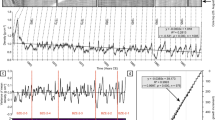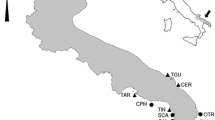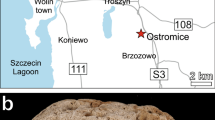Abstract
The skeleton morphology of the azooxanthellate cold-water coral Lophelia pertusa can be strongly influenced by invasive boring sponges that infest corallites in the still living part of the colony. Atypically swollen corallites of live Lophelia pertusa from the Galway Mound (Belgica Carbonate Mound Province, Porcupine Seabight, NE Atlantic), heavily excavated by boring organisms, have been examined with a wide range of non-destructive and destructive methods: micro-computed tomography, macro- and microscopic observations of the outer coral skeleton, longitudinal and transversal thin sections and SEM analyses of coral skeleton casts. As a result, three excavating sponge species have been distinguished within the coral skeleton: Alectona millari, Spiroxya heteroclita and Aka infesta. Furthermore, four main coral/sponge growth stages have been recognised: (1) cylindrical juvenile corallite/no sponge cavities; (2) flared juvenile corallite/linear sponge cavities (if present); (3) slightly swollen adult corallites/chambered oval sponge cavities; (4) very swollen adult corallites/widespread cavities. The inferred correlation between corallite morphology and boring sponge infestation has been detected in micro-computed tomography (micro-CT) images and confirmed in sponge trace casts and peculiar features of coral skeleton microstructure.











Similar content being viewed by others
References
Beuck L (2002) Biodegradation und Ichnodiversität postmortaler Stadien der Tiefwasserkoralle Lophelia pertusa am Propeller Mound (Porcupine Seabight). MSc Thesis, Eberhard-Karls-Universität, Tübingen, Germany, 77 pp
Beuck L (2005) Sediment sampling and processing. In: Pfannkuche O, Utecht C (eds) Cruise report Poseidon 316: carbonate mounds and aphotic corals in the NE-Atlantic. Reykjavik-Lissabon 03.08-17.08. 2004. IFM-GEOMAR Report 3:17–59
Beuck L, Freiwald A (2005) Bioerosion patterns in a deep-water Lophelia pertusa (Scleractinia) thicket (Propeller Mound, northern Porcupine Seabight). In: Freiwald A, Roberts JM (eds) Cold-water corals and ecosystems. Springer, Heidelberg, pp 915–936
Bromley RG, Martinell J (1991) Centrichnus, new ichnogenus for centrally patterned attachment scars on skeletal substrates. Bull Geol Soc Den 38:243–252
Bromley RG, D’Alessandro A (1984) The ichnogenus Entobia from the Miocene, Pliocene and Pleistocene of southern Italy. Riv Ital Paleont Stratigr 90:227–296
Cairns SD (1979) The deep-water Scleractinia of the Caribbean Sea and adjacent waters. Stud Fauna Curaçao Caribb Isl 57:1–341
Cedhagen T (1994) Taxonomy and biology of Hyrrokkin sarcophaga gen. et sp. n.: a parasitic foraminiferan (Rosalinidae). Sarsia 79:65–82
De Mol B, van Rensbergen P, Pillen S, Van Herreweghe K, Van Rooij D, McDonnell A, Huvenne V, Ivanov M, Swennen R, Henriet JP (2002) Large deep-water coral banks in the Porcupine Basin, southwest of Ireland. Mar Geol 188:193–231
De Mol B, Henriet J-P, Canals M (2005) Development of coral banks in Porcupine Seabight: Do they have Mediterranean ancestors? In: Freiwald A, Roberts JM (eds) Cold-water corals and ecosystems. Springer, Heidelberg, pp 515–533
Duncan PM (1877) On the rapidity of growth and variability of some Madreporaria on an Atlantic cable, with remarks upon the rate of accumulation of foraminiferal deposits. Ann Mag Nat Hist 20:361–365
Freiwald A, Schönfeld J (1996) Substrate pitting and boring pattern of Hyrrokkin sarcophaga Cedhagen, 1994 (Foraminifera) in a modern deep-water coral reef mound. Mar Micropaleont 28:199–207
Freiwald A, Henrich R, Pätzold J (1997) Anatomy of a deepwater coral reef mound from Stjernsund, West-Finnmark, northern Norway. SEPM Spec Publ 56:41–161
Freiwald A, Wilson JB (1998) Taphonomy of modern deep, cold-temperate water coral reefs. Hist Biol 13:37–52
Gravier C (1920) Madreporaires provenant des campagnes des yachts Princesse-Alice et Hirondelle II (1893-913). Resultats des campagnes scientifiques accomplies sur son yacht par Albert Ier Prince Souverain de Monaco 55:1–123
Harmelin JG (1990) Deep-water crisiids (Bryozoa: Cyclostomata) from the northeast Atlantic Ocean. J Nat Hist 24:1597–1616
Hubbard JAEB, Pocock YP (1984) Scleractinian functional morphology: a key to paleoecological reconstruction. Palaeont Am 54:523–530
Huthnance J, Coelho H, Griffith CR, Knight PJ, Rees AP, Sinha B, Vangriesheim A, White M, Chatwin PG (2001) Physical structures, advection and mixing in the region of Goban Spur. Deep-Sea Res Part II 48:2979–3021
Kalender WA (2005) Computed tomography. Fundamentals, system technology, image quality, applications. Publicis, Erlangen, Germany, 306 pp
Kaszemeik K, Freiwald A (2002) Lophelia pertusa (Scleractinia)—from skeletal structures to growth patterns and morphotypes. In: A Freiwald (ed) ACES Atlantic coral ecosystem study. Fifth Management Report. Institute for Geosciences, Tübingen University, Germany, pp 1–26
López Correa M, Freiwald A, Hall-Spencer J, Taviani M (2005) Distribution and habitats of Acesta excavata (Bivalvia: Limidae), with new data on its shell ultrastructure. In: Freiwald A, Roberts JM (eds) Cold-water corals and ecosystems. Springer, Heidelberg, pp 173–205
Masson DG, Miles PR (1986) Structure and development of Porcupine Seabight sedimentary basin, offshore southwest Ireland. AAPG Bull 70:536–548
Mietchen D, Keupp H, Manz B, Volke F (2005) Non-invasive diagnostics in pathological fossils by magnetic resonance imaging. Biogeosci Discuss 2:239–260
Nickel M, Donath T, Schweikert M (2006a) Functional morphology of Tethya species (Porifera): 1. Quantitative 3D-analysis of Tethya wilhelma by synchrotron radiation based X-ray microtomography. Zoomorphology. doi:10.1007/s00435-006-0021-1
Nickel M, Bullinger E, Beckmann F (2006b) Functional morphology of Tethya species (Porifera): 2. Three-dimensional morphometrics on spicules and skeleton superstructures of T. minuta. Zoomorphology. doi:10.1007/s00435-006-0022-0
Pfannkuche O, Utecht C (2005) Cruise report Poseidon 316: carbonate mounds and aphotic corals in the NE-Atlantic. Reykjavik-Lissabon 03.08-17.08, 2004. IFM-GEOMAR Rep 3:1–61
Pomponi SA (1979) Ultrastructure of cells associated with excavation of calcium carbonate substrates by boring sponges. J Mar Biol Assoc UK 59:777–784
Roberts JM (2005) Reef-aggregating behaviour by eunicid polychaete symbionts of cold-water corals: Do worms assemble reefs? J Mar Biol Assoc UK 85:813–819
Rossi M, Casali F, Romani D, Bondioli L, Macchiarelli R, Rook L (2004) MicroCT scan in paleobiology: application to the study of dental tissues. Nucl Instrum Methods 213:747–750
Rützler K, Rieger G (1973) Sponge burrowing: fine structure of Cliona lampa penetrating calcareous substrata. Mar Biol 21:144–162
Schönberg CHL (2001) Estimating the extent of endolithic tissue of a Great Barrier Reef clionid sponge. Senckenb Marit 31:29–39
Seguenza G (1864) Disquisizioni paleontologiche intorno ai Corallarii fossili delle rocce terziarie del distretto di Messina. Mem Real Accad Sci Torino (ser 2) 21:399–560
Siegel LJ (2003) Preemies from the Precambrian. Astrobiology Magazine. http://www.astrobio.net. Cited 14 February 2007
Stolarski J (1995) Ontogenetic development of the thecal structures in caryophylliine scleractinian corals. Acta Palaeontol Pol 40:19–44
Stolarski J (1996) Gardineria: a scleractinian living fossil. Acta Palaeont Pol 41:339–367
Strømgren T (1971) Vertical and horizontal distribution of Lophelia pertusa (Linné) in Trondheimsfjorden on the west coast of Norway. Det Kongelige Norske Videnskabers Selskabs Skrifter 6:1–9
Taylor PD, Wilson MA (2002) A new terminology for marine organisms inhabiting hard substrates. Palaios 17:522–525
Van Rooij D, De Mol B, Huvenne V, Ivanov M, Henriet JP (2003) Seismic evidence of current-controlled sedimentation in the Belgica Mound Province, upper Porcupine slope, southwest of Ireland. Mar Geol 195:31–53
Van Soest RWM, Picton B, Morrow C (2000) Sponges of the North East Atlantic. Biodiversity Center of ETI, Multimedia Interactive Software. UNESCO, Paris
Veron JEN (2000) Corals of the world, vols 1–3. In: Stafford-Smith M (ed), Australian Institute of Marine Science, Townsville, Australia, 463 pp
Vertino A (2003) Sclerattiniari Plio-Pleistocenici ed attuali del Mediterraneo (Sistematica, Biostratinomia e Paleoecologia). PhD Thesis, University of Messina, 306 pp
Wells JW (1957) Coral Reefs. In: Hedgepeth JW(ed), Treatise on Marine Ecology and Paleoecology. Mem Geol Soc Am 67:609–631
Zibrowius H (1980) Les Scléractiniaires de la Méditerranée et de l’Atlantique nord-oriental. Mém Instit Océanogr Monaco 11:284
Zibrowius H (1984) Taxonomy in ahermatypic scleractinian corals. Paleont Am 54:80–85
Acknowledgements
We are indebted to André Freiwald (Erlangen, Germany), Jarek Stolarski (Warsaw, Poland), Antonietta Rosso (Catania, Italy) and Rossana Sanfilippo (Catania, Italy) for valuable discussions. We thank Richard G. Bromley (Copenhagen, Denmark), Helmut Zibrowius (Marseille, France) and an unknown reviewer for their constructive comments on this paper. Furthermore, we are beholden to Birgit Leipner-Mata for the preparation of thin sections, to Christian Schulbert (Erlangen, Germany) for configuring the colour balance in our figures, to the Marum Company (Bremen, Germany), especially Volker Ratmeyer, for providing us with ROV-Quest images from the study area (Meteor cruise 61/3) and Tim Beck for microscopic images of the living polyps and for the gastropod identification. We express our gratitude to the captain and crew of RV Poseidon and to the Rosenstiel Museum (Miami, Florida). The study was funded by the HERMES Project GOCE-CT-2005-511234 (Hotspot Ecosystem Research on the Margins of European Seas) and the EURODOM Project HPRN-CT-2002-00212 (European Deep Ocean Margins: a new training-through-research frontier).
Author information
Authors and Affiliations
Corresponding author
Electronic supplementary material
Below are the Electronic Supplementary Materials.
3D2_2 (MPG 3.93 Mb)
Rights and permissions
About this article
Cite this article
Beuck, L., Vertino, A., Stepina, E. et al. Skeletal response of Lophelia pertusa (Scleractinia) to bioeroding sponge infestation visualised with micro-computed tomography. Facies 53, 157–176 (2007). https://doi.org/10.1007/s10347-006-0094-9
Received:
Accepted:
Published:
Issue Date:
DOI: https://doi.org/10.1007/s10347-006-0094-9




